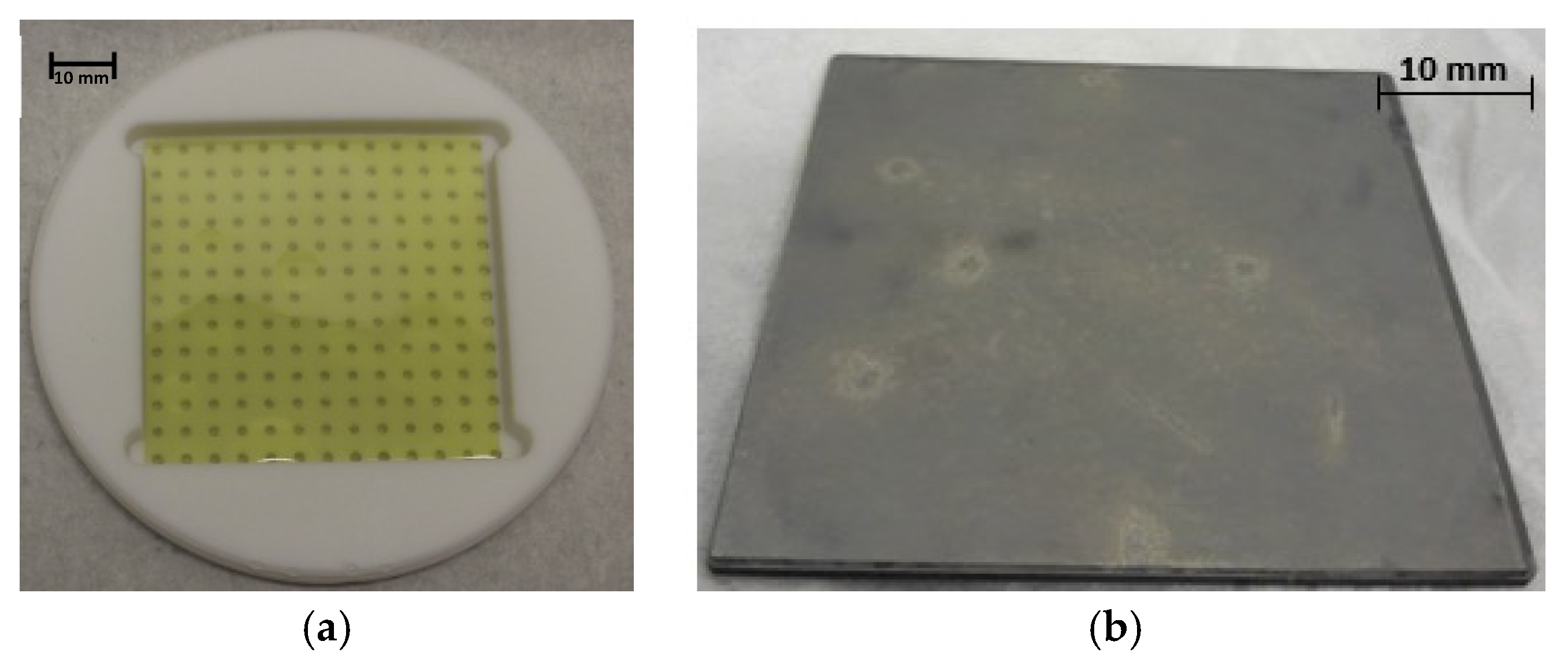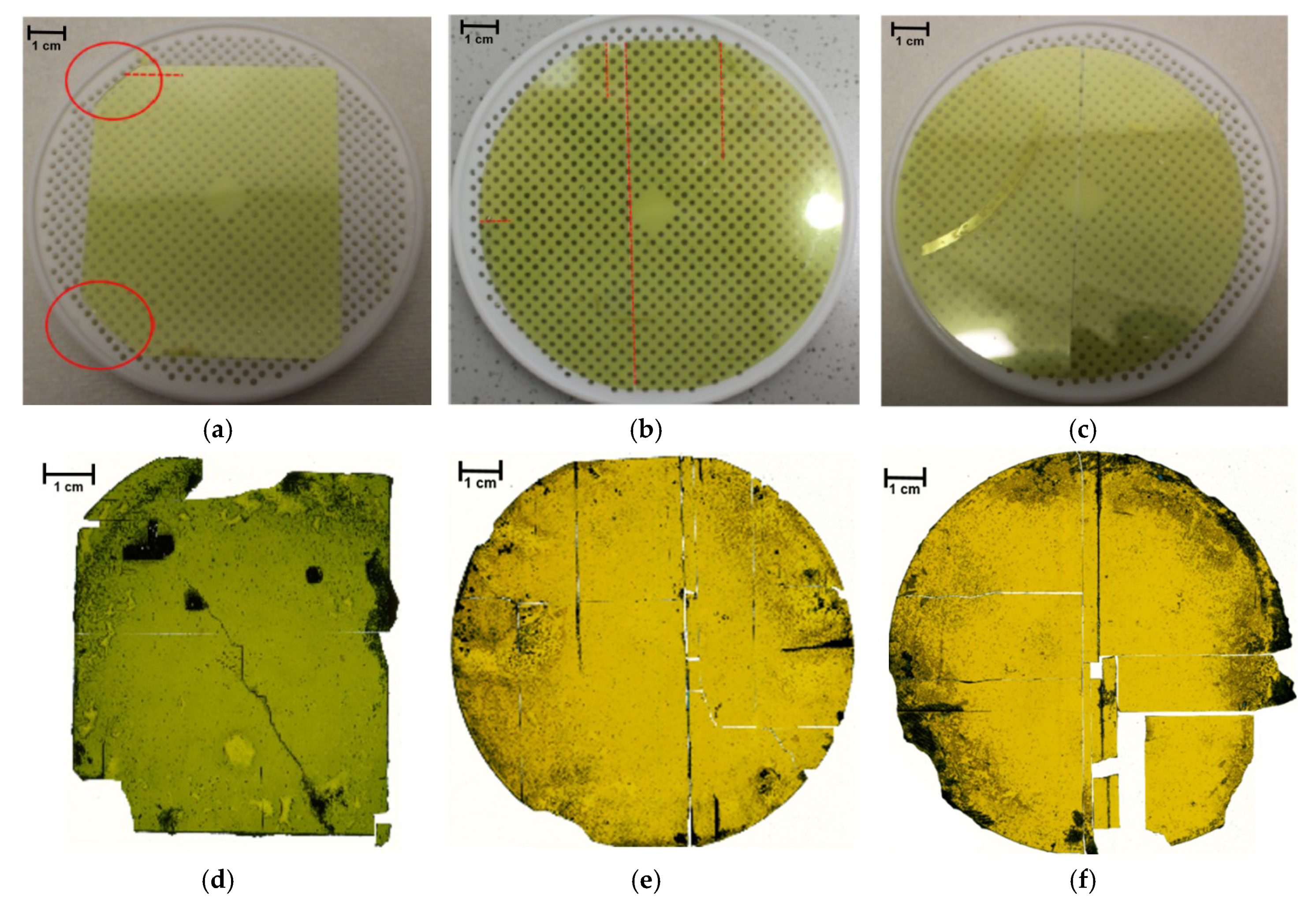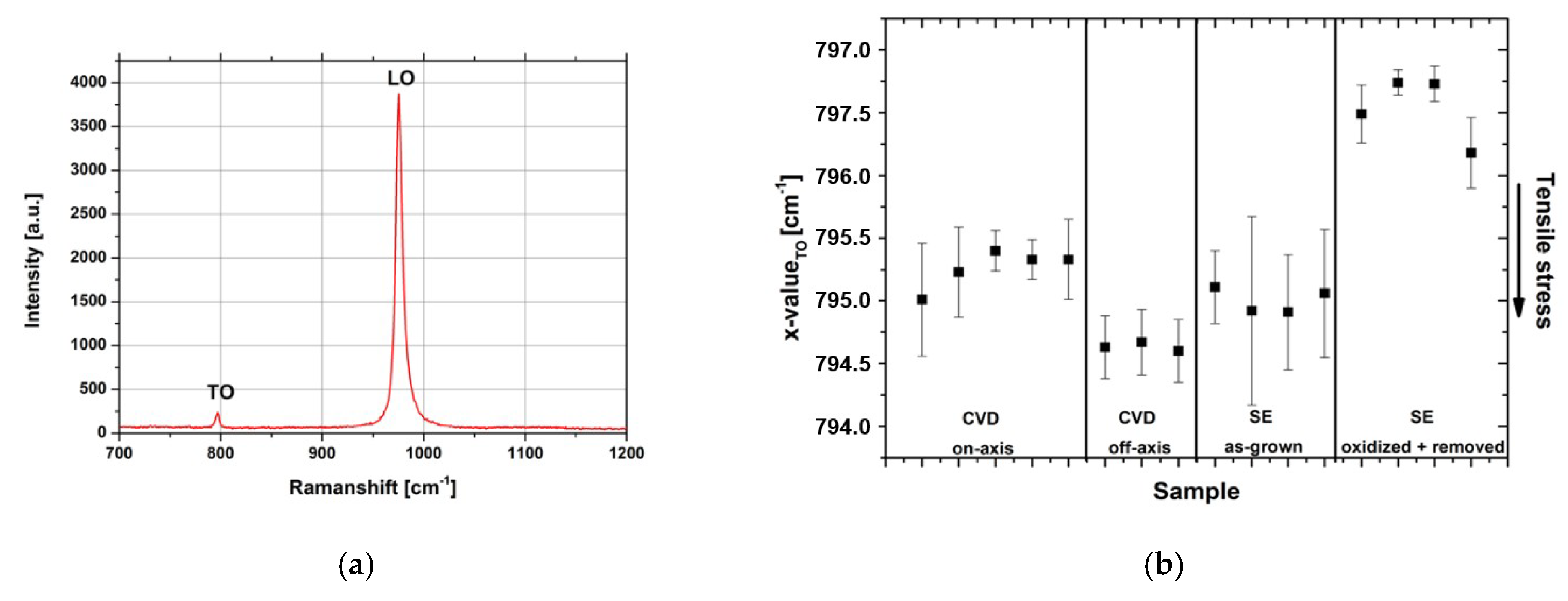Growth of Large-Area, Stress-Free, and Bulk-Like 3C-SiC (100) Using 3C-SiC-on-Si in Vapor Phase Growth
Abstract
:1. Introduction
2. Experimental Methods
3. Results and Discussion
4. Conclusions
Author Contributions
Funding
Conflicts of Interest
References
- Rengarajan, V.; Xu, X.; Wu, P.; Gupta, A.; Ramm, M.; Zwieback, I.; Rulan, G. Growth of Large Diameter SiC Single Crystals. In Proceedings of the International Conference on Silicon Carbide and Related Materials (ICSCRM 2017), Washington, DC, USA, 17–22 September 2017. [Google Scholar]
- Wellmann, P.J. Review of SiC crystal growth technology. Semicond. Sci. Technol. 2018, 33, 103001. [Google Scholar] [CrossRef]
- Wellmann, P.; Neubauer, G.; Fahlbusch, L.; Salamon, M.; Uhlmann, N. Growth of SiC bulk crystals for application in power electronic devices-process design, 2D and 3D X-ray in situ visualization and advanced doping. Cryst. Res. Technol. 2015, 50, 2–9. [Google Scholar] [CrossRef]
- Schöner, A.; Krieger, M.; Abe, G.P.M.; Nagasawa, H. Fabrication and Characterization of 3C-SiC-Based MOSFETs. Chem. Vap. Depos. 2006, 12, 523–530. [Google Scholar] [CrossRef]
- Tairov, Y.M.; Tsvetkov, F.V. Studies of Growth Kinetics and Polytypism of Silicon Carbide Epitaxial Layers Grown from the Vapour Phase. J. Cryst. Growth 1976, 36, 147–151. [Google Scholar] [CrossRef]
- Yoshikawa, T.; Nishino, S.; Araie, J. The effect of source powder height on the growth rate of 3C-SiC grown by the sublimation technique. Silicon Carbide Relat. Mater. 1995, 142, 61–64. [Google Scholar]
- Jokubavicius, V.; Yazdi, G.R.; Liljedahl, R.; Ivanov, I.G.; Yakimova, R.; Syväjärvi, M. Lateral Enlargment Growth Mechanism of 3C-SiC on off-oriented 4H-SiC Substrates. Cryst. Gorwth Des. 2014, 14, 6514–6520. [Google Scholar]
- La Via, F.; Severino, A.; Anzalone, R.; Bongiorno, C.; Litrico, G.; Mauceri, M.; Schöler, M.; Schuh, P.; Wellmann, P.J. From thin film to bulk 3C-SiC growth: Understanding the mechanism of defects reduction. Mater. Sci. Semicond. Process. 2018, 78, 57–68. [Google Scholar] [CrossRef]
- Zimbone, M.; Mauceri, M.; Litrico, G.; Barbagiovanni, E.G.; Bongiorno, D.; La Via, F. Protrusion reduction in 3C-SiC thin film on Si. J. Cryst. Growth 2018, 498, 248–257. [Google Scholar] [CrossRef]
- La Via, F.; Roccaforte, F.; La Magna, A.; Nipoti, R.; Mancarella, F.; Wellmann, P.J.; Crippa, D.; Mauceri, M.; Ward, P.; Miglio, L.; et al. 3C-SiC Hetero-Epitaxially Grown on Silicon Compliance Substrates and New 3C-SiC Substrates for Sustainable Wide-Band-Gap Power Devices (CHALLENGE). Mater. Sci. Forum 2018, 924, 913–918. [Google Scholar] [CrossRef]
- Schuh, P.; Schöler, M.; Wilhelm, M.; Syväjärvi, M.; Litrico, G.; La Via, F.; Mauceri, M.; Wellmann, P.J. Sublimation growth of bulk 3C-SiC using 3C-SiC-on-Si (100) seeding layers. J. Cryst. Growth 2017, 478, 159–162. [Google Scholar] [CrossRef]
- Queren, D.; Friedrich–Alexander University Erlangen–Nürnberg, Germany. Personal communication, 2006.
- Chaussende, D.; Mercier, F.; Boulle, A.; Conchon, F.; Soueidan, M.; Ferro, G.; Mantzari, A.; Andreadou, A.; Polychroniadis, E.K.; Balloud, C.; et al. Prospects for 3C-SiC bulk crystal growth. J. Cryst. Growth 2008, 310, 976–981. [Google Scholar] [CrossRef]
- Schöler, M.; Schuh, P.; Steiner, J.; Wellmann, P.J. Modelling of the PVT growth process of bulk 3C-SiC—Growth process development and challenge of the right materials data base. In Proceedings of the European Conference on Silicon Carbide and Related Materials (ECSCRM 2018), Birmingham, UK, 2–6 September 2018. [Google Scholar]
- Fu, C.; Yang, Y.; Huang, Z.; Liu, G.; Zhang, H.; Jiang, F.; Wie, Y.; Jiao, Z. Investigation on the laser ablation of SiC ceramics using micro-Raman mapping technique. J. Adv. Ceram. 2016, 5, 253–261. [Google Scholar] [CrossRef]
- Zoppel, S.; Fasari, M.; Merz, R.; Zehetner, J.; Stangl, G.; Reider, G.A.; Fotakis, C. Laser micro machining of 3C-SiC single crystals. Microelectron. Eng. 2006, 83, 1400–1402. [Google Scholar] [CrossRef]
- Feng, Z.C.; Mascarenhas, A.J.; Choyke, A.J.; Powell, W.J.; Powell, J.A. Raman scattering studies of chemical-vapor-deposited cubic SiC films on (100) Si. J. Appl. Phys. 1988, 64, 3176–3186. [Google Scholar] [CrossRef]




| Sample | Orientation | a ‖ (Å) | a ⊥ (Å) | ε |
|---|---|---|---|---|
| SE123 | On-axis | 4.3599 | 4.3602 | −7.9 × 10−5 |
| SE126 | On-axis | 4.3617 | 4.3608 | 2.1 × 10−4 |
| 3C-SiC-on-Si | On-axis | 4.3628 | 4.3582 | 1.1 × 10−3 |
| SE136 | 4° off | 4.3602 | 4.3602 | −3.7 × 10−6 |
| SE137 | 4° off | 4.3605 | 4.3602 | 7.1 × 10−5 |
| 3C-SiC-on-Si | 4° off | 4.3633 | 4.3582 | 1.2 × 10−3 |
© 2019 by the authors. Licensee MDPI, Basel, Switzerland. This article is an open access article distributed under the terms and conditions of the Creative Commons Attribution (CC BY) license (http://creativecommons.org/licenses/by/4.0/).
Share and Cite
Schuh, P.; La Via, F.; Mauceri, M.; Zielinski, M.; Wellmann, P.J. Growth of Large-Area, Stress-Free, and Bulk-Like 3C-SiC (100) Using 3C-SiC-on-Si in Vapor Phase Growth. Materials 2019, 12, 2179. https://doi.org/10.3390/ma12132179
Schuh P, La Via F, Mauceri M, Zielinski M, Wellmann PJ. Growth of Large-Area, Stress-Free, and Bulk-Like 3C-SiC (100) Using 3C-SiC-on-Si in Vapor Phase Growth. Materials. 2019; 12(13):2179. https://doi.org/10.3390/ma12132179
Chicago/Turabian StyleSchuh, Philipp, Francesco La Via, Marco Mauceri, Marcin Zielinski, and Peter J. Wellmann. 2019. "Growth of Large-Area, Stress-Free, and Bulk-Like 3C-SiC (100) Using 3C-SiC-on-Si in Vapor Phase Growth" Materials 12, no. 13: 2179. https://doi.org/10.3390/ma12132179
APA StyleSchuh, P., La Via, F., Mauceri, M., Zielinski, M., & Wellmann, P. J. (2019). Growth of Large-Area, Stress-Free, and Bulk-Like 3C-SiC (100) Using 3C-SiC-on-Si in Vapor Phase Growth. Materials, 12(13), 2179. https://doi.org/10.3390/ma12132179






